By Rick Bernardi
One day, when I was a kid, I was riding my bike, when the neighbor across the street beckoned me over. The neighbor, who was the father of one of the neighborhood kids, saw that I had my bike lock wrapped around my seatpost, and said he wanted to show me something. My “lock” was a chain—a very thin, cheap chain—with a cheap integrated combination lock attached. He asked me to lock my bike with it, so I did. Then he started working the combination, and within a few seconds, he opened the lock.
I was dumbfounded. I couldn’t believe somebody could open my combination lock like that. My confidence in my “invincible” bike lock was thoroughly shaken. Why was he messing with my lock like that? And what if somebody else could open my lock? Looking back, years later, I realize he was doing me a favor. He was showing me how easy it was to defeat my crappy lock. He could have done it with a pair of wire cutters too, but I guess he made his point without actually breaking my lock. Like I said, he did me a favor.
Over the years, I’ve moved up to better bikes, and what I probably assumed were better locks, eventually arriving at some serious locking power. But the more I’ve learned about bike theft, the more I’ve come to understand that there’s no such thing as a bike lock that can’t be defeated.
And you know what? It doesn’t really matter. When it comes to bike theft we really don’t need to make the perfect the enemy of the good. A good lock is almost always going to be good enough.
Almost. Because if somebody really wants to steal your particular bike, and they have the time, the tools, the know-how, and the brazenness, whatever lock you’re using can probably be defeated. And if it can’t, whatever you’ve locked your bike to can probably be defeated.
But that’s not how bike theft actually works.
Most bike theft reports indicate a crime of opportunity, where the theft victim left the bike unlocked and unattended for “just a minute.” The next most common type of bike theft is the kind “low-hanging fruit” that opportunistic bike thieves prefer—bikes that are locked with cheap locks or are locked improperly.
- Related Article: Ciao, Milano
Some bike thieves work solo, but some work in teams of three. The first team member scouts the bike rack for easy targets. After scouting the bikes, he rides off or walks away. His behavior may be suspicious, but he hasn’t broken any laws.
The second team member arrives. His job is to cut or break the lock. The first team member has told him which bike to work on, and what tools he will need. When he’s done, he leaves without taking the bike. Worst case scenario for him if he’s apprehended, he vandalized your bike lock.
The third team member arrives. Your bike is sitting there unlocked, and he rides off with it. If he’s caught, he can be arrested on a larceny charge, which can be either a misdemeanor or a felony, depending upon the dollar value of your bike. But because your bike was unlocked when he arrived, he spent no time and aroused no suspicion breaking locks. All he did was get on your bike and ride away. The chance that he will be caught in the act approaches zero.
Whether the thief is a solo act, or a member of a team, the goal is the same—to steal a bike fast, with as little fanfare and as little suspicion as possible. And so the strategy for locking a bike will always be to make it more difficult to steal your bike, and spend more time than he wants to spend breaking your lock. It’s not that your lock can’t be broken given the right tools and enough time, it’s that you’re making it as difficult and time-consuming as possible for the thief. The opportunistic bike thief isn’t going to waste any time trying to break your lock when there’s a perfectly good, poorly locked bike right next to yours.
The one exception to this rule is that there are steal-to-order bike theft rings, and there are professional bike theft rings that scout for high-end bikes to steal. They are far less common than your average bike thief who needs some quick cash for a quick fix, but they are out there. So if you’ve got a valuable and/or highly desirable bike, “good enough” may not be good enough, and the professionals might just be determined enough to take the time and make the effort to break your “invincible” bike lock. And of course, if you leave your Pinarello Dogma F12 locked to a street signpost for a week, or even a night, there is a chance—quite possibly a very good chance—that it won’t be there when you return for it.
- Related Article: Pop Quiz: Bike Theft
But assuming that you’re not leaving your Pinarello out on the street overnight, what can you do to convince almost every bike thief out there to move on to lower-hanging fruit? Read on.
How To Lock Your Bike
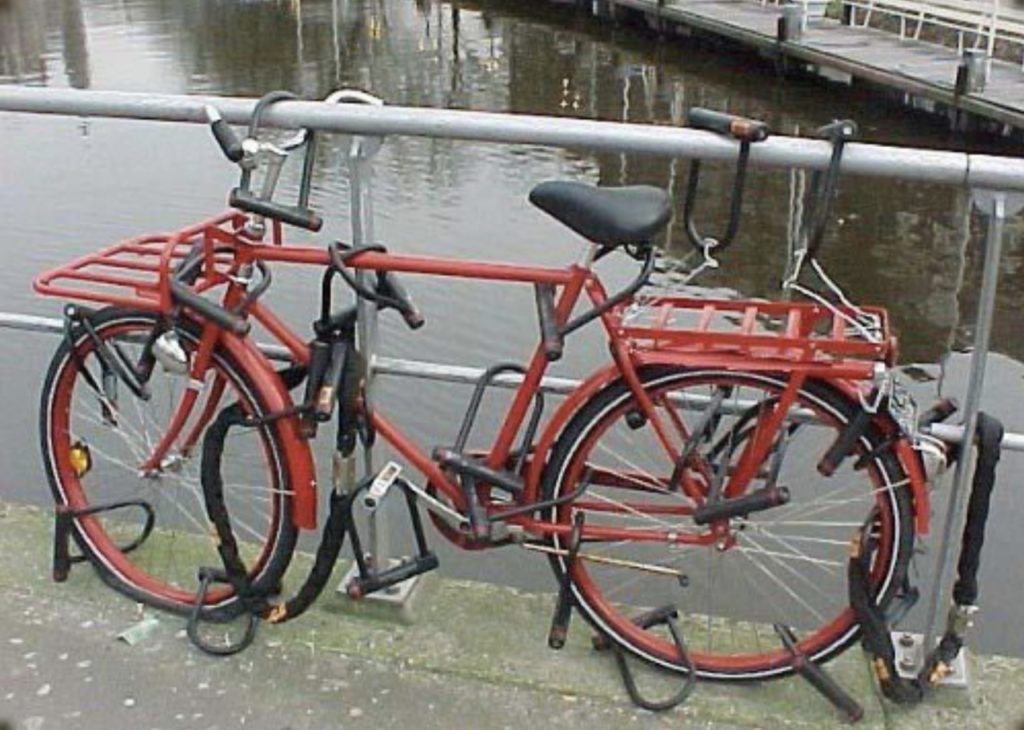
There are two essential things you need to do to properly lock your bike: You have to pick a proper lock, and you have to use proper locking technique.
If you have a good lock, but don’t use it properly, your bike may be gone when you return. And if you have your locking technique perfected, but are using a cheap, easily broken lock, you may still find that your bike still is gone when you return. And a bad lock and bad locking technique? Well now you’re just asking for trouble.
Choosing A Bike Lock
So let’s start by talking about locks. There are only two types of locks you should consider for your bike. One is a u-lock (preferably heavy-duty) made by one of the reputable, brand-name bike lock companies. The other is one of the heavy-duty chain and lock combinations made by the same reputable, brand-name lock companies. And between the two types of locks, the heavy-duty chain and lock is the most difficult type of lock for thieves to cut. Some cyclists even choose to use both types of locks.
Do not use a cable lock or light-duty chain—they can be easily cut, literally within a second of a thief’s attack. Simply put, a cable lock will not deter a bike thief. Don’t waste your money on one—buy a real bike lock instead (But note: I actually use a heavy-duty cable to loop through my wheels, in addition to my regular u-lock). In high-risk areas, you may even want to use a combination of a u-lock and a heavy-duty chain. Using these two different types of heavy-duty locks together will encourage almost every thief to move on to another, more easily stolen bike.
Of course, your level of security will depend upon what you’re doing, and where you’re locking up. If you’re a roadie out on your training ride, the last thing you want is to be lugging a heavy-duty u-lock and heavy-duty chain along with you. A light cable or strap lock might be sufficient. If you live in a low-crime suburban area and you’re making a quick run to the local café, the heavy-duty locks may not be necessary. On the other hand, if your bike is locked up at the college campus bike rack (a prime cruising area for bike thieves), or you’re locked up in a gritty urban area, those heavy-duty locks may be essential for convincing local bike thieves that your bike takes too much work to steal.
You should also consider what thieves are looking for: Bikes, wheels, saddles, and accessories like lights are particularly attractive, either because they are valuable, or because they are easily-removed, or both. In some areas, thieves may even be interested in stripping your handlebars or high-end components off your bike. At a minimum, you should put some thought into locking anything that can be removed quickly—basically, your wheels and your saddle—and taking easily-removed accessories such as lights with you.
Once you have a serious bike lock, you will need to use proper locking technique—no lock can prevent theft if it’s used improperly. As an example, many cyclists who have used a good-quality u-lock to lock their bike to a bike rack by the front wheel have returned to find the front wheel still locked to the rack, and the rest of the bike gone. They don’t call quick-release wheels “quick-release” for nothing…
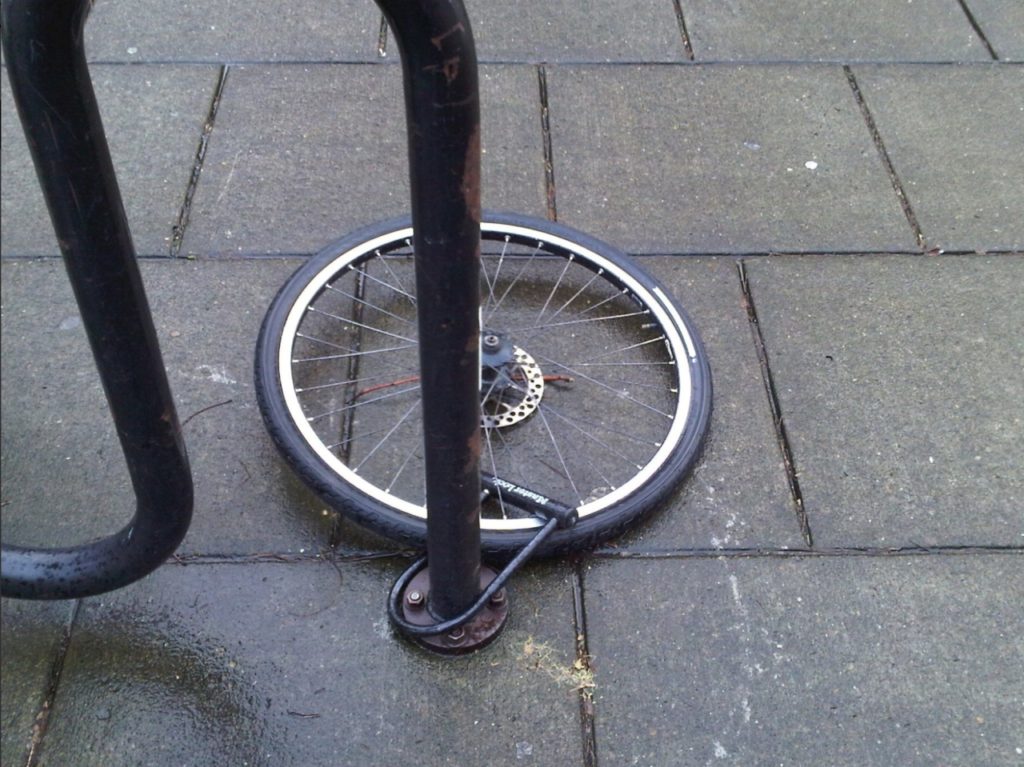
Proper Locking Technique:
Choosing What You Should Lock Your Bike To
The rule of thumb you will want to follow is to lock your bike to a metal structure that is securely fastened in cement or otherwise fastened securely to the cement, and which cannot be easily cut or dismantled. If you are locking to a metal pole, make sure that it is securely fastened in cement, or that the bolts are not loose or easily removed.
Here’s why: Bike thieves have devised several variations of what is known as a “sucker pole.” The idea is they remove the bolts from the pole, or cut the pole and then slide a smaller diameter pole inside, then slide the cut pole like a sleeve over the smaller pole, to make the pole seem safe to lock your bike to. Once you’ve left, the thief can come and quickly remove the pole, take your bike, and then put the “sucker pole” back in place, ready for their next victim. To keep yourself from being a victim of these theft operations, always check the pole to make sure that it is secure. Also, be aware that thieves have been known to remove traffic signs from poles and then slide the bike up over the pole.
Never lock your bike to a wooden railing or small tree—thieves have been known to cut through these to remove the bike. Choose a well-lit area with pedestrian traffic. You will want the smallest lock that will secure your bike to a rack. Your u-lock is at its strongest when there is no extra space between the bike, the rack, and the lock in which a thief can slip a lever or a jack. If you have large gaps between the lock and the rack, your lock is too big for the job—get a smaller lock.
Well, what about a bike rack? That’s safe, right?
Not necessarily.
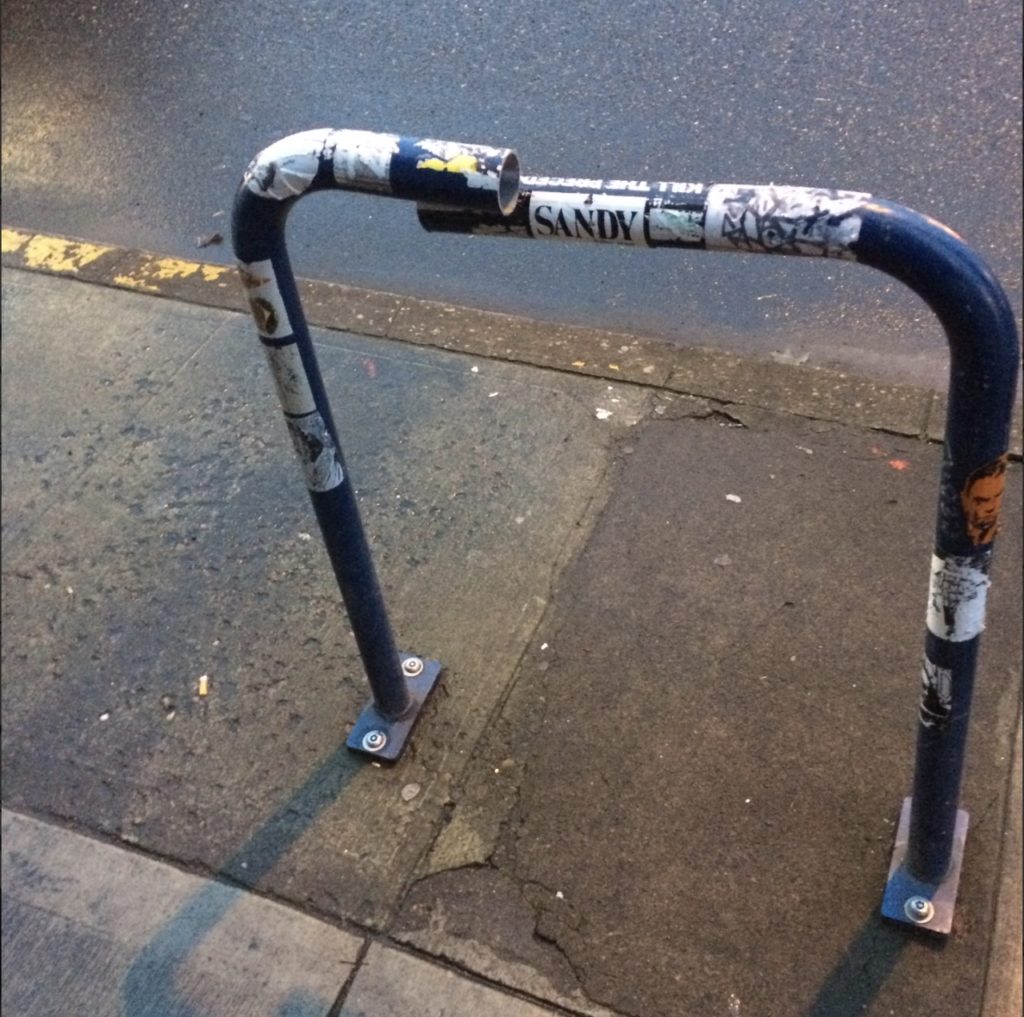
Thieves have been known to cut through bike racks. They have even made bike rack versions of the “sucker pole”: One version removes the bolts keeping the bike rack secured to the ground. The other version involves cutting through the bike rack ahead of time, concealing the cut with tape or bumper stickers, and waiting for an unsuspecting cyclist to lock up. Either way, the “sucker rack” is the gift that keeps on giving to the patient bike thief. Portland, Oregon has responded to these bike theft tactics by designing new types of bike racks to further deter bike thieves.
- Related Article: In War Over Parking, Cyclists Look to Lock Bikes
One More Bike Thief Trick You Need To Know About
Picture this: You come back to your bike at the end of the day and discover that it’s got a flat tire. Or maybe somebody has locked their bike to yours. Or you even find someone has locked your bike to the rack with their u-lock.
Are you thinking about going home to get a spare tube, and coming back tomorrow? Or coming back tomorrow, after the other bike locked to your bike is gone? Or coming back tomorrow with tools to break the stranger’s u-lock?
Notice that each of these scenarios involve you leaving, to come back later—probably tomorrow? That’s the idea—this is a common tactic for bike thieves who want to steal a well-locked bike. If they disable your bike, there’s a good chance you’ll go home without your bike, and that gives the thief time to work on your lock while you are at home working on a plan to get your bike home.
Of course, if you do find that you’ve got a flat when you arrive at the bike rack, it could just be a flat. But you can’t rule out that it’s a ploy to get you to go home without your bike. And if you return to find somebody else’s lock on your bike, assume that it’s a bike theft ploy, and come up with a plan to get your bike unlocked before the thief does. If your plan is to get law enforcement involved, you will need to be able to prove that it’s your bike.
Proper Locking Technique
So you’ve got your bike documented and insured, you’ve got your locks, you’re ready to roll, and when you get there, you want the odds on your side if a bike thief happens to be nearby scouting for bikes to steal.
What do you need to know?
First, let’s talk about some common bike-locking mistakes. These common mistakes are
Locking the front wheel only: One mistake that is commonly seen is locking the front wheel of the bike to a bike rack or pole.

This technique is a great method to keep your front wheel from being stolen. However, it does absolutely nothing to prevent at thief from taking the rest of your bike. As I said above, they don’t call quick-release wheels “quick-release” for nothing.
Locking the front wheel and bike frame only: This is another common mistake, this time locking the front wheel and frame of the bike to a bike rack or pole.
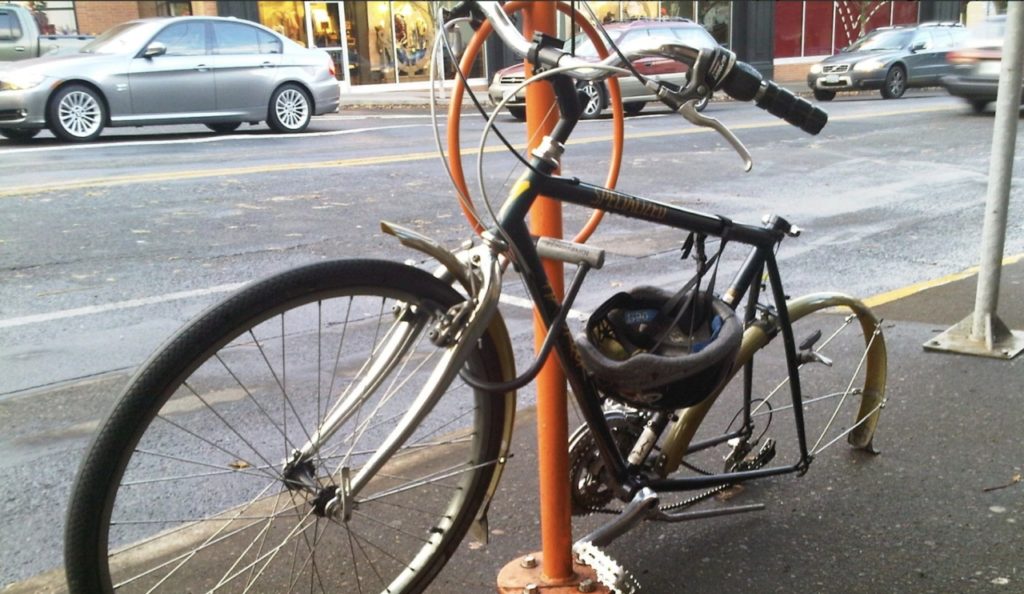
This is an effective locking method for ensuring that the bike thief will only steal your rear wheel. Again, they don’t call quick-release wheels “quick-release” for nothing.
Locking the frame only: And finally, for those rides home when you don’t need either of your wheels, you can lock your frame to the bike rack or pole, while leaving both quick-release wheels available for the local bike thief.
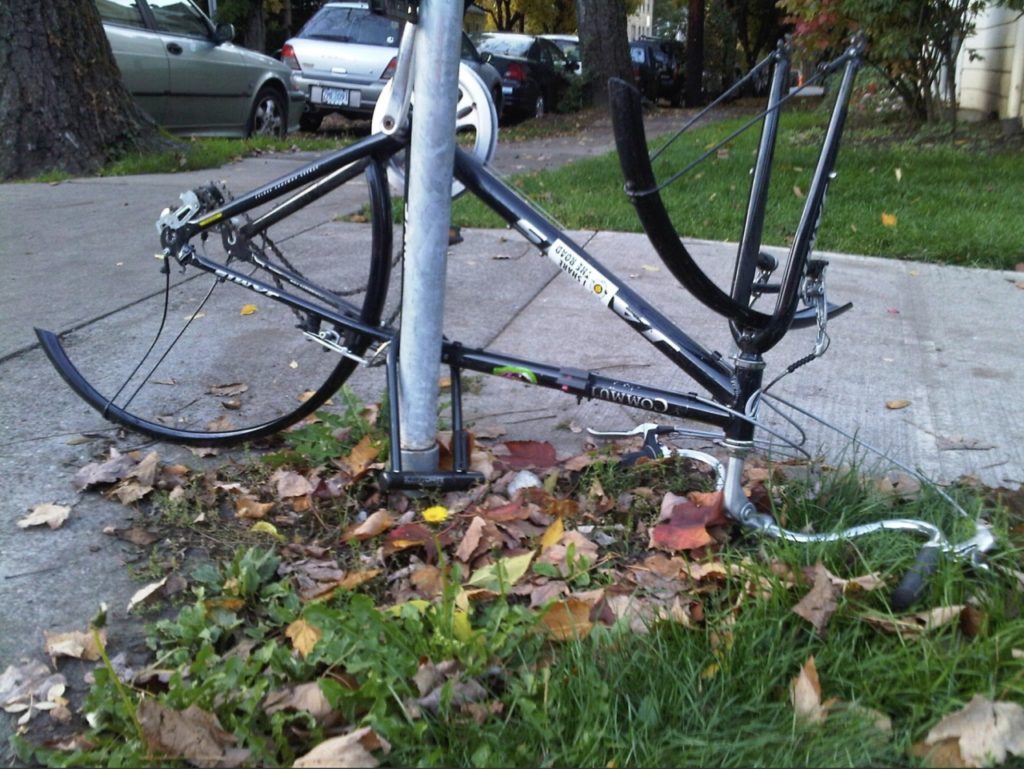
So now that you’ve seen bad locking technique from the eyes of a bike thief, let’s talk about good locking technique. A good starting place for proper locking strategy is the advice from the late, great Sheldon “Belt and Suspenders” Brown. I don’t follow all of his advice (particularly in regards to riding a beater to discourage thieves), and his techniques can be defeated. But still, his advice is worth reading and it makes as good a place as any to discuss locking strategy. The basics of Sheldon Brown’s strategy are:
- A small u-lock. Brown recommends the Kryptonite Mini, which I use myself. I also have the Kryptonite Fahgettaboudit, which I rarely use due to its significantly heavier weight and larger size. I also have a Kryptonite heavy-duty cable (mine comes with my mini u-lock), a Kryptonite integrated lock cable, and a New York Legend chain/lock combo. Something for every occasion. I’m not plugging Kryptonite, or recommending a specific brand of lock. There are several other excellent brands on the market. I’m just talking about my own lock set up, and how my lock strategy lines up with Sheldon Brown’s lock strategy. The reason Brown suggests the smaller u-locks is so there’s no gap between the shackles of the lock between which a thief can insert a prybar or a jack to break the lock apart.
- Place the lock around the rear wheel, inside the rear triangle. This is important: the u-lock MUST be inside the rear triangle or this technique is easily defeated, leaving you with a rear wheel and no bike.
- The “U” is against the pole: Make sure that the “U” is placed against the pole, and the flat bar is against the bike. This gives a thief less space inside the lock to insert a tool to lever it open.
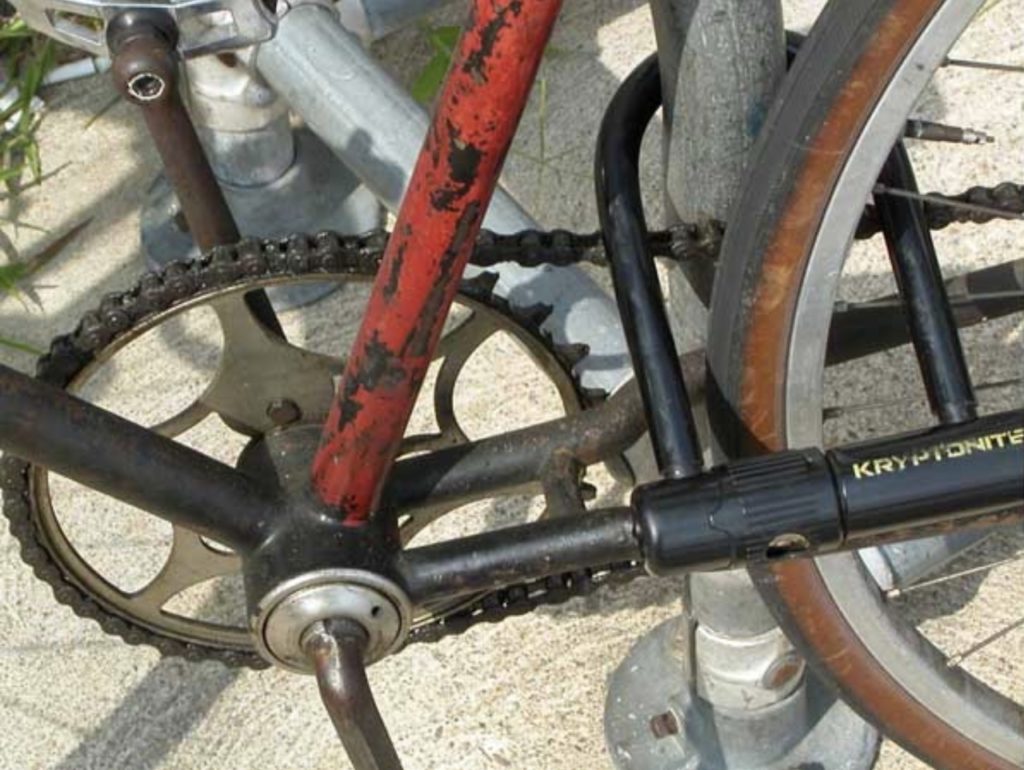
U-lock around the rear wheel, inside the rear triangle. Note that Sheldon Brown’s “beater bike” is part of his anti-theft strategy.
That’s it. Brown’s locking theory relies upon his argument that (1) it’s too difficult to hacksaw through the rear wheel, (2) the rear wheel is the most expensive part of the bike after the frame (so the thief would be reluctant to destroy the rear wheel to get the bike) and (3) that it doesn’t really happen in the real world.
However, his argument that it’s difficult to cut through the rear wheel has been debunked:
Well, why not lock around the frame instead of the rear wheel? Good question. By locking around the rear wheel only, a smaller u-lock can be used, making it harder to get a jack between the shackles of the lock and break the lock open. But you can achieve the same result by locking the seat tube to the rack or pole. This is the method I use, combined with a heavy-duty cable looped through the wheels and secured by the mini u-lock. This protects my frame and my wheels. Yes, a thief could cut the cable, but it hasn’t happened yet. Still, an even more secure method of locking the wheels and the saddle would be to install a set of Pitlock locking skewers and seat post binder. And not only more secure, but more elegant, and one less lock to carry with me too.
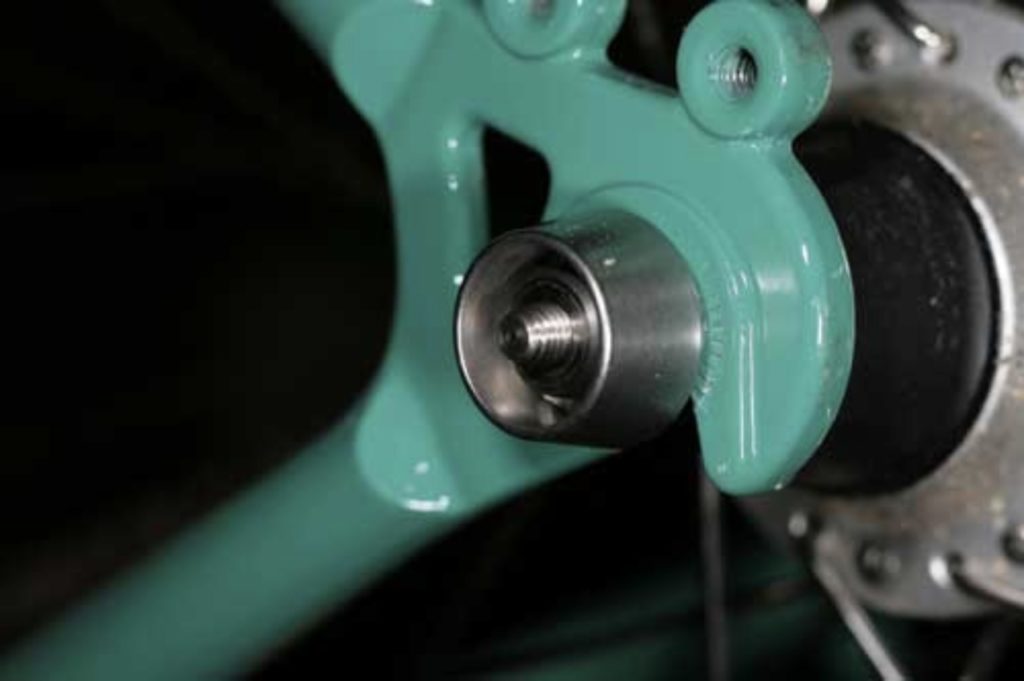
Another company making complete sets of locks for total bike security (locking skewers, seatpost binders, frame locks, chains, even headset locks!) is Pinhead; one great feature of pinhead lock sets is that you only need one key for the entire set.
A modified version of the Sheldon Brown lock strategy is suggested on 802BikeGuy:
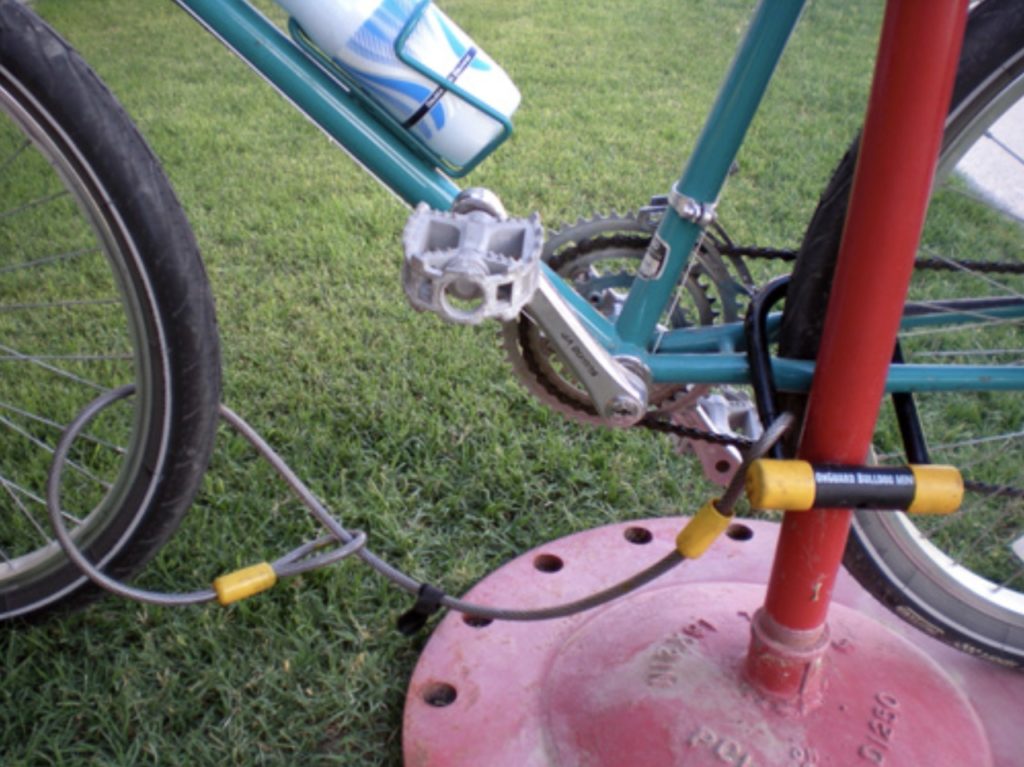
In this strategy, the u-lock locks both the rear wheel and one of the chainstays, while a cable loops through the front wheel. This keeps both the rear wheel and frame protected by the u-lock, and the front wheel protected by the cable.
Another method is to lock around both the rear wheel and the seat tube, and to loop a cable through the front wheel, as pictured here:
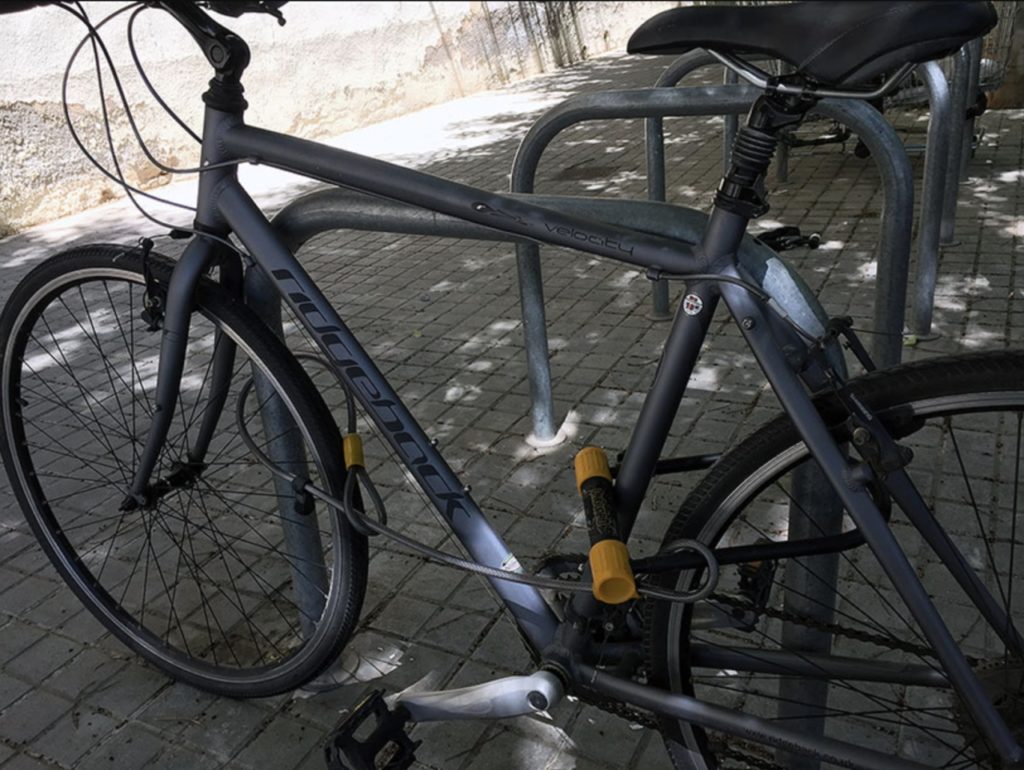
This and other locking strategies can be found at How to lock your bike.
But Beware—a word of warning about locking the bike by the frame: If you lock it by the top tube instead of the seat tube, a bike thief now has a giant lever—your bike frame—with which to break the lock. The problem is that giant lever (your bike frame) is going to get dented and smashed and twisted while the bike thief is working on your lock. The bike thief doesn’t really care, because he only needs to sell your bike for enough cash to buy his next fix. The other problem is that this method only works on cheap u-locks, so if you have a good-quality u-lock, you could come back to find that while you haven’t lost your bike to a thief, you now have a pretzeled bike. Save yourself the grief of riding a pretzel home and don’t lock your bike by the top tube.
Location and time are important components of a good locking strategy. There are two more important factors you need to take into consideration in proper locking technique—location, and time.
- Choose your locking location carefully: Busy streets with lots of witnesses will be less appealing to thieves than a deserted area with few witnesses. But be aware that in at least one instance, thieves attempted to steal a locked bike while the owner was seated only a few feet away. And there’s a famous video circulating out there of a “bike thief” (actually, video-makers the Neistat brothers cutting their own lock on their own bike) cutting locks on busy streets filled with passersby; one “Good Samaritan” bystander even offers helpful advice to the “thief” as he cuts the lock.
While it’s unlikely that a real bike thief will be this bold, real thieves do steal right out in the open if they can do it quickly and unobtrusively.
Watch How Long It Takes For A Thief To Snatch A Locked Bicycle
Nevertheless, you stand a better chance of deterring a thief if your bike is in a busy location with lots of potential witnesses passing by. The reason may have less to do with passersby, or police, than it does with you. While passersby may continue on their way without confronting the thief, he is under constant pressure to finish the theft before you return—and the thief likely has no idea who owns the bike, and when you will return. On a busy street, any one of those people on the street could be you, approaching him while he is attempting to break your lock on your bike. A random passerby may or may not leave him alone, but he knows that you will see things very differently than the random passerby, so he needs to get the job done fast. And that is where the second important factor comes in:
- Time is of the essence: While there’s no such thing as a theft-proof lock and locking technique, the advantage you give yourself with a good lock and locking technique is the element of time. A cheap cable can be cut in seconds. A cheap lock can be cut just as fast. But a high-quality lock, combined with proper locking technique, will take the thief considerably more time to defeat. And time is something the thief would very much prefer not to spend when stealing a bike, especially when there are so many other bikes nearby that are locked with a cheap cable, or a cheap lock, or that are even left unlocked and unattended for “just a minute.” For a bike thief, those bikes are considerably more attractive targets for theft, so why would he waste any time trying to defeat your lock and your locking technique? Unless you’ve locked up your bike—especially an expensive and desirable bike—on a deserted street overnight (never a good idea, just don’t do it) he won’t.And that is the other element of time you need to be aware of. Depending on your habits, the thief may be able to guess when you will return. If you lock up to the same rack at the same time every day, and leave at the same time every day, an attentive thief may be able to figure out how much time he has to break your lock, as well as what tools he will need. If you lock up outside a movie theater, the thief may be able to deduce what time you will return. If you leave your bike out overnight every night, the thief will be able to gauge your habits and know what tools he will need. And so on. To keep the thieves guessing, don’t give them clues about where you are and when you will return. Keep them nervous and wanting to move on to better targets.
Other locking tips you should be aware of
- Never place your u-lock close to the ground, because a thief can use the ground as an excellent leverage point to attack your lock with a large, heavy-duty bolt cutter. The ground also makes an excellent anvil for any thief who wants to smash your lock with a heavy hammer. You can make your bike harder to steal by keeping your lock away from the ground.
Bolt Cutters vs. Kryptonite Lock
- Face the key opening of your lock down, towards the ground. This makes it harder for the thief to attack the lock and protects the lock from the elements as well.
- You can protect your bolt-on components too. You can keep thieves from stealing your handlebar and stem, and any of your components secured by an allen bolt, by filling the allen bolt recesses with something to slow the thieves down. Some people will place a ball bearing in the bolt recess, and then fill the recess with wax or silicone sealant. A more elegant solution is a Hexlox keyed magnet that plugs the Allen bolt recess.
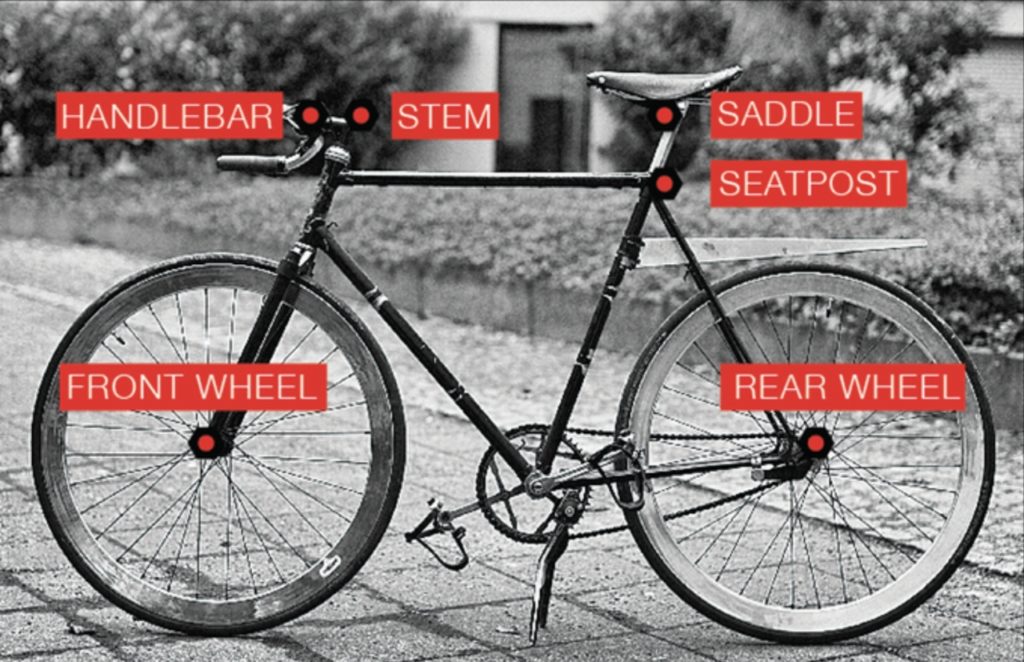
Hexlox replaces these quick releases and Allen bolts
Either way slows the thief down. As always, the idea is to convince the thief to move on to another bike that isn’t as well-protected as yours.
- Don’t forget to protect your saddle. If you don’t, and a thief steals your saddle, you may need to ride home standing on the pedals all the way. There are (very) small cables for to locking your saddle to your frame, which are intended to be on your bike at all times. But these are easily snipped with a pair of wire cutters; they’re really only designed to stop the “honest people” from stealing your saddle. The only real way to keep your saddle from being stolen is to lock it securely, either with a loop a heavy chain through the saddle rails and your bike frame, or with a Hexlox replacement bolt. Alternatively, you can remove your seat post and saddle and take them with you when you lock up, but you’ll have to reset your seat post height when you return.
- Don’t leave your accessories on your bike. When you lock up, bring your lights, water bottles, panniers and bags, and whatever other accessories you have on your bike with you. Accessories are typically removed very easily and will likely be gone when you return to your bike if you forget to take them with you. Make it a habit.
- The safest place for your bike will always be out of the thief’s sight, behind locked doors. At home, keep it in your garage, inside your home, or in a locked storage locker in your building. Never outside overnight. At work, or school, or at a transit station, a storage locker will always be safer than locking it outside.
And in this corner…
All of these bike locking techniques really only have one goal—to convince a bike thief that stealing your bike will slow him down so much that he decides to move on to another, easier target. Again, time is of the essence to the thief, because the longer he takes stealing your bike, the greater the chance he will be discovered. And what he really wants to avoid is having you walk up on him while he is busy cutting your lock. The police might not notice. Passersby might not notice, or care. But you will notice, and you will care. At best, you are likely to call the cops. But at worst, he’s at risk of being attacked, and he knows it.
It’s not uncommon or unusual that cyclists who have had their beloved rides stolen would thirst for some vigilante justice. Bob Mionske wrote about this phenomenon in Ciao, Milano, his personal account of his own stolen bicycle:
“What is it about a bike theft that brings out the incivility in us?
The same guy who is aghast at the thought of waterboarding willingly shares his bike thief torture fantasies on the internet.
Of course, it is probably just hyperbole in most cases, and even if you have a fantasy about beating someone, chances are you have never really been in a real fight. If you really managed to confront the thief, he is not likely going to be impressed with the fact that your fight record is an undefeated 1-0 because you stood up to that little bully Billy at day care 30 years ago, and it will give you cold comfort when facing someone who may be younger, bigger and stronger than you.
Or worse, crazier…”
Years before Bob wrote that, a cyclist even wrote in to Bob to tell about his own encounter with a bike thief:
“Several months ago, I stopped for coffee at the end of my morning bike commute. While in line at the coffee shop, I saw someone ride up on another bike, pull out a pair of cable cutters and snip through the cable lock on my bike. I rushed outside, pushed him off my bike just as he was about to run away, and confronted him. We got into a fight (his corner: 6 foot 2-ish, around 200 pounds and alleged to be high on methamphetamine; my corner: 5 foot 9, 150 pounds and hadn’t even had my morning coffee yet), and he hit me in the head with his cable cutters. It took three “Good Samaritans” to intercede, stop the beating and hold him down until the police arrived.
The end results:(1) I ended up with six stitches in my head, $700 in out-of-pocket medical expenses and a missed day of work to make up. One of the Good Samaritans got bitten- fortunately, the thief appears to be HIV and Hepatitis C negative. (2) The police pulled a six-inch knife out of the guy’s pocket- lucky for me that he didn’t think to use it. (3) The thief recently pled guilty to assault and got nine months in jail, of which he had served over half at the time of sentencing. (4) One of the defense’s main arguments appeared to be that I had provoked the attack, and he had merely defended himself.”
Something to think about before you catch a bike thief in the act and think you want to open up a can of whoop-ass.
A Final Thought
Remember, ANY lock can be broken. I’ve said it repeatedly. Your goal will always be to convince the bike thief to look for an easier bike to steal.
And that sucks. Our thinking has been reduced to “Steal that other cyclist’s bike, not mine.”
It shouldn’t have to be that way. We should help each other. We should protect each other. We should not be debased by bike thieves into hoping that somebody else did a poor job of locking their bike up. Instead, let’s lift each other up, make each other stronger, watch out for each other. Let’s refuse to buy stolen bikes because they’re a good deal—we all know a shady deal when we see one. And let’s think about the parted bike parts market too—how do we keep the chop shops from injecting stolen bike parts into the legitimate bike parts market? I don’t know if there’s an answer to that one, but as long as there’s a market for stolen bikes and stolen bike parts, bike theft will continue to be a lucrative business, and we’ll continue to be forced to go the extra mile to convince bike thieves to steal someone else’s bike.
Showtime!
There are many excellent videos out there demonstrating excellent locking technique, how easy it is to defeat poor locking technique, and even how easy it is to break a lock with the right know-how and equipment. Some of my favorites feature the always-entertaining New York City bike mechanic and urban-locking expert Hal Ruzal. Here are a few that are recommended viewing:
Hal Ruzal Grades Your Bike Locking (2011)
Hal Grades Your Bike Locking 2014 (Part IV)
***
Disclaimer: The bicycle locking techniques discussed in this article are provided as information solely for the general interest of the visitors to this website. Bicycle Law makes no guarantee, express or implied, about the locks or locking techniques discussed in this article.
For More Information:
For more information about protecting yourself from bike theft, see About Bike Theft
For more information about insuring your bike against loss from theft, and filing a claim if your bike is stolen, see Insurance Advice.
For more MUST-READ articles about bike theft and locking your bike, see:
- Chasing My Stolen Bicycle
- Inside San Francisco’s Stolen Bike Warehouse
- This Is What Happens To Your Bike After It’s Stolen
- Who Pinched My Ride?
- Who’s Trying To Steal Your Bike (And What Tools Are They Using?)
- Your U-Lock Is Basically Worthless, But Don’t Worry
Bonus Video: Undercover Cops Catch A Bike Thief In The Act
